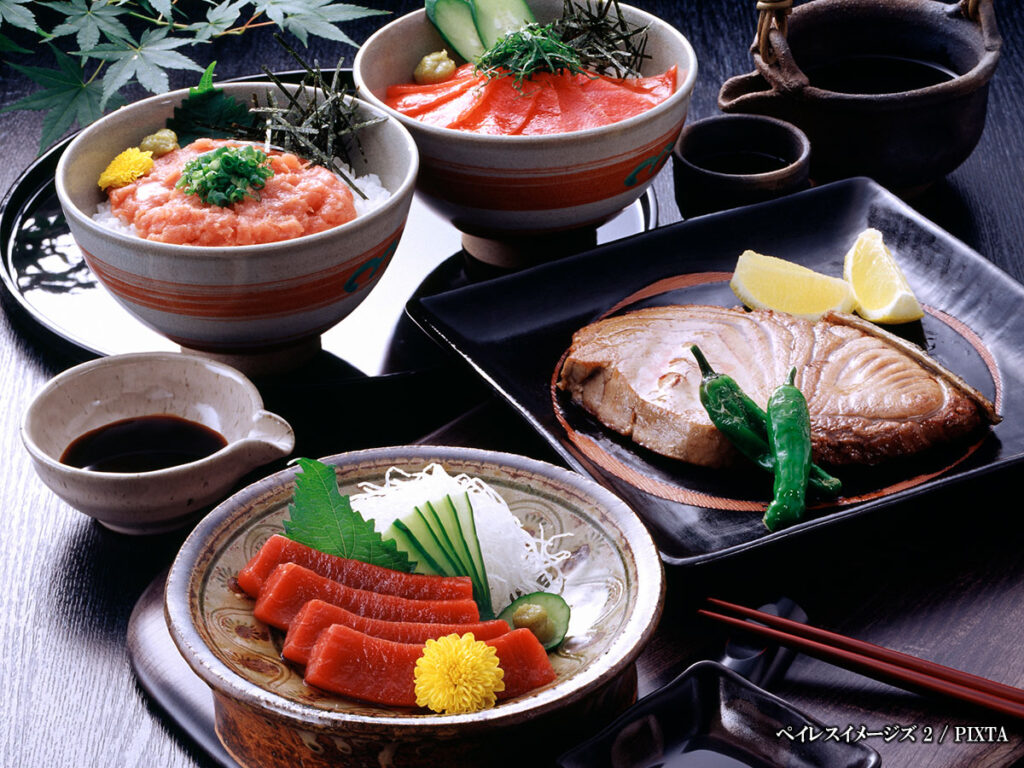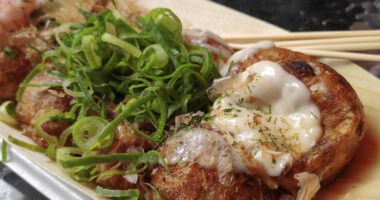Tuna, or maguro as it’s known in Japan, is a key player in Japanese cuisine. While most people immediately think of tuna when they hear the word “sushi,” Japan’s culinary traditions go far beyond that. This fish isn’t just about delicate raw slices on rice. It takes on many forms, each with its own preparation style, history, and unique taste.
From fresh and simple sashimi to hearty tuna steaks, maguro takes center stage in a variety of Japanese dishes. Whether it’s lightly seared, simmered to perfection, or served in a flavorful rice bowl, each preparation brings out a different side of this prized fish.
In this guide, we’re exploring five amazing dishes which are either traditional Japanese or inspired by Japanese cuisine—sushi, sashimi, soy-marinated tuna rice bowl, tuna steak, and braised tuna. You’ll learn where they come from, how they’ve changed over time, and the best ways to prepare them, both traditionally and with a modern twist.
Let’s begin with the most famous example, sushi.
Maguro no nigirizushi (tuna nigiri)
Origin and evolution of sushi
Sushi is one of Japan’s most famous and beloved dishes, but it wasn’t always the bite-sized delicacy we know today. It began as a way to preserve fish by fermenting it with rice, a method that originated in Southeast Asia before making its way to Japan. Over time, the fermentation process was replaced by fresh fish and vinegared rice, evolving into nigirizushi, the hand-pressed sushi style commonly eaten today.
Maguro became especially popular during the Edo period (1603–1868) when sushi stalls in Tokyo (then Edo) started serving fresh fish directly over rice. Maguro’s deep, umami-rich flavor and smooth texture made it a sushi favorite, with different cuts—akami (lean), chūtoro (medium-fatty), and ōtoro (fatty)—offering a variety of tastes and textures.
Maguro no nigirizushi is a staple in sushi restaurants across Japan. You can find it everywhere, from casual conveyor-belt spots to high-end omakase experiences.
Recipe and preparation
Making maguro nigiri at home is simple but requires high-quality tuna and properly seasoned rice.
Ingredients
- 7 oz (200g) fresh maguro slices (akami, chūtoro, or ōtoro)
- 2 cups (320g) sushi rice
- ¼ cup (60ml) rice vinegar
- 1 tbsp (12g) sugar
- ½ tsp (3g) salt
- Soy sauce and wasabi (to taste)
Steps
- Cook sushi rice and mix with vinegar, sugar, and salt while it’s still warm. Let it cool to body temperature.
- Slice tuna into thin, even pieces.
- Wet hands with vinegar water and shape the rice into small oval mounds.
- Place a thin slice of tuna over each rice mound and press gently to secure it.
- Serve with soy sauce and wasabi.
Fusion and variations
While classic maguro nigiri remains a favorite, modern chefs have introduced creative twists. Some high-end restaurants top the tuna with truffle oil, caviar, or even edible gold leaf. Other popular variations are tuna with avocado or yuzu zest as well as aburi (torched) tuna. Some sushi shops catering to an international clientele may even include spicy ingredients which are more popular outside of Japan.
Best pairings
Traditional maguro nigiri is best enjoyed with gari pickled ginger, soy sauce, and wasabi. For a complete meal, pair it with miso soup or a cup of Japanese green tea.
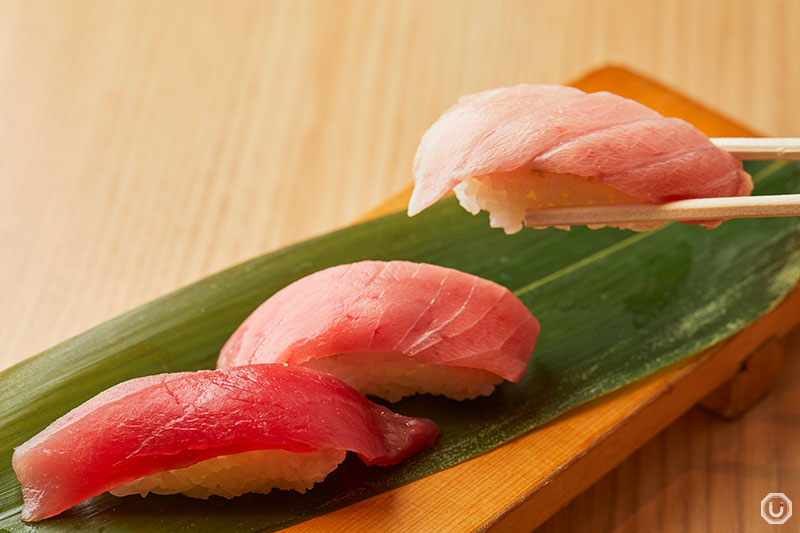
Maguro nigiri at Magurobito Akihabara, Tokyo (photo for illustrative purposes)
Maguro no sashimi (tuna sashimi)
Origin and evolution
Sashimi is one of the purest ways to enjoy fresh seafood in Japan, with origins dating back to the Heian period (794–1185). Unlike sushi, which pairs raw fish with vinegared rice, sashimi consists of expertly sliced fish served on its own. Maguro remains a top choice for sashimi due to its smooth texture and deep umami flavor. Over the centuries, chefs have refined their slicing techniques, ensuring the perfect cut enhances both taste and presentation.
Recipe and preparation
This recipe requires high-quality tuna and precise knife skills.
Ingredients
- 5.3 oz (150g) fresh maguro (sashimi-grade, preferably akami, chūtoro, or ōtoro)
- 2 tbsp (30ml) soy sauce (for dipping)
- ½ tsp (2g) wasabi paste or fresh-grated wasabi if you can find it (adjust to taste)
- 2 tbsp (30g) grated daikon radish (for garnish)
- 2–3 green shiso (perilla) leaves (for added freshness)
Steps
- Choose fresh, sashimi-grade tuna. The quality of the fish is crucial, as sashimi is eaten raw.
- Use a sharp knife to cut the tuna into even slices. Traditionally, each slice is about ½-inch thick to achieve the perfect texture.
- Arrange the slices neatly on a plate. Japanese presentation values aesthetics, so take your time plating.
- Serve with soy sauce, wasabi, and grated daikon radish. The balance of flavors enhances the natural taste of the tuna.
Fusion and variations
While classic maguro sashimi is served as is, modern chefs love experimenting with new flavors. One popular variation is zuke maguro, where the tuna is lightly marinated in soy sauce and mirin, giving it a richer, deeper taste. Some contemporary takes also include a drizzle of citrus (like yuzu) or a sesame oil infusion for extra complexity. In fusion cuisine, maguro sashimi is sometimes paired with avocado or truffle oil for a luxurious twist.
Best pairings
Tuna sashimi is often served as an appetizer and pairs beautifully with traditional Japanese drinks. Sake (especially dry varieties) and shōchū complement the dish’s delicate flavors. For a non-alcoholic option, green tea or iced mugicha (barley tea) make refreshing choices.
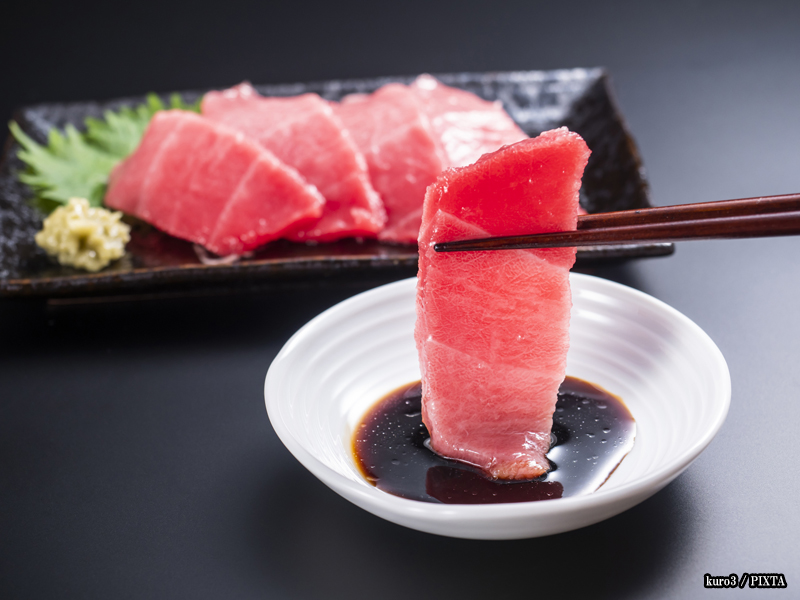
Photo for illustrative purposes
Maguro no zuke don (soy-marinated tuna rice bowl)
Origin and evolution
Maguro no zuke don is a delicious and satisfying rice bowl that has deep roots in Japan’s food culture. In this context, don refers to the dish itself — short for donburi, a word that can mean both the bowl and the food served in it. This style of meal originated as a quick and hearty way for workers to enjoy flavorful toppings over steamed rice.
Chefs have long perfected maguro no zuke don by marinating the tuna before serving. Soaking it in soy sauce, mirin, and sake enhances its flavor while gently curing the fish. Today, this delicious dish is a favorite in sushi bars, donburi specialty spots, and home kitchens alike.
Recipe and preparation
Ingredients (serves three people)
- 16 oz (450g) fresh tuna (sashimi-grade)
- 3 cups (540g) cooked Japanese rice
- 4½ tbsp (67ml) soy sauce
- 1½ tbsp (22ml) mirin
- 1½ tbsp (22ml) sake
- 1½ tsp (7.5ml) sesame oil (optional)
- 1½ tsp (7.5ml) sesame seeds
- 1½ green onions (finely chopped) — or 2 small green onions
Steps
- Slice the tuna into thin pieces, about ¼-inch thick.
- In a bowl, mix soy sauce, mirin, and sake. Add sesame oil for extra depth.
- Place the tuna slices in the marinade and let them sit for about 30 minutes.
- Fill a bowl with warm, steamed rice.
- Arrange the marinated tuna slices on top of the rice.
- Garnish with sesame seeds, green onions, and shredded nori.
Fusion and variations
Some restaurants serve it with a raw egg yolk on top for extra creaminess. Others introduce spicy mayo, avocado slices, or even truffle oil for a fusion-style upgrade. Some regions in Japan also swap out regular soy sauce for yuzu-infused soy sauce, giving the dish a refreshing citrusy touch.
Best pairings
To balance the rich flavors, maguro zuke don is best enjoyed with miso soup and pickled vegetables. Some people also like to have it with a side of wasabi for a sharp, spicy kick.
Tuna steak
Origin and evolution
While raw tuna remains the heart of Japanese cuisine, seared and grilled preparations have gained popularity, bringing out the fish’s rich umami while adding a satisfying texture. Maguro steak is one such dish—a perfect blend of traditional Japanese flavors and Western culinary techniques. Lightly seared on the outside yet tender inside. In Japan, it’s typically seasoned with soy sauce and garlic, but here’s a Western twist with herbs and spices.
Recipe and preparation
Ingredients (serves three people)
- 12 oz (340g) tuna steak (sashimi-grade)
- 1½ small dried red chilies (crushed)
- 1½ tbsp (22ml) coriander seeds (toasted and ground)
- ¾ clove garlic (minced)
- 1½ tbsp (22ml) chopped fresh coriander (about 3 tbsp loosely packed)
- 1½ tbsp (22ml) chopped fresh basil (about 3 tbsp loosely packed)
- 1½ tbsp (22ml) olive oil
- 1½ lemons (or juice to taste)
- Salt and black pepper to taste
Steps
- Crush the chili and coriander seeds using a mortar and pestle.
- Add minced garlic, chopped basil and coriander, olive oil, and lemon juice. Mix well and season with salt and black pepper.
- Rub the herb mixture over both sides of the tuna steak and let it marinate for 15–20 minutes.
- Heat a griddle or frying pan over high heat and lightly coat with olive oil.
- Sear the tuna for 45–60 seconds on each side until browned on the outside and still pink inside.
- Finish with a squeeze of lemon juice.
Fusion and variations
- Sesame-crusted tuna steak: Coat the tuna with a layer of sesame seeds before searing for a crunchy texture.
- Miso-glazed tuna steak: Brush with a miso-honey glaze for a richer, slightly sweet taste.
- Italian and Latin American fusion: Pair with a balsamic reduction or chimichurri sauce for a unique twist.
Best pairings
Tuna steak pairs beautifully with steamed rice, sautéed vegetables, or a crisp Japanese salad.
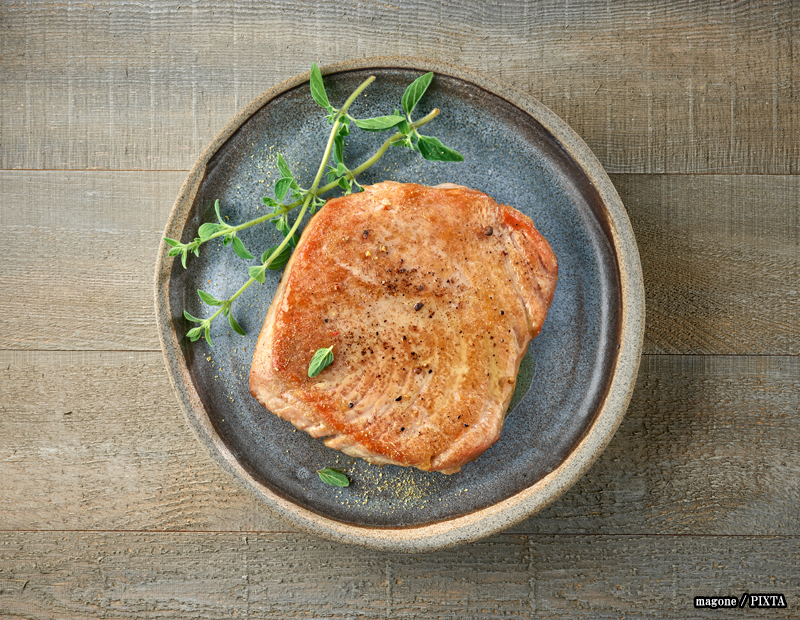
Photo for illustrative purposes
Maguro no nitsuke (braised tuna)
Maguro no nitsuke (braised tuna), is a dish that brings out the rich flavors of tuna through slow simmering in a soy sauce-based broth. This traditional Japanese cooking technique creates a tender, flavorful dish that pairs beautifully with simple sides like steamed rice and pickles.
Recipe and preparation
Ingredients (serves three people)
- 12 oz (340g) fresh tuna fillets (cut into bite-sized pieces)
- ½ cup (120ml) soy sauce (preferably shoyu)
- ¾ cup (180ml) sake
- 3 tbsp (45ml) mirin
- 3 tbsp (38g) granulated sugar
- 12 to 15 oz (360–450ml) ginger ale
- 3 pieces ginger
Steps
- Place the raw tuna in a deep dish and pour the hot boiling water over it. The outer layer of the tuna will turn slightly whitish-grey. Immediately remove the tuna or drain it.
- Peel the ginger and grate half of it, then slice the rest into thin matchstick pieces.
- In a medium pot, combine the soy sauce, sake, mirin, sugar, ginger ale, and ginger. Bring the mixture to a boil over medium-high heat, then reduce the heat to a simmer.
- Add the cubed tuna and cover with a drop lid. Let it simmer for 1 hour.
- Serve the dish hot alongside steamed rice and pickled vegetables.
Fusion and variations
If you can handle a bit of heat, adding chili peppers can give it a spicy kick. Some chefs also experiment with miso for extra depth or use butter and garlic to introduce a Western-inspired richness.

Photo for illustrative purposes
Final thoughts
Just imagine the irresistible thought of biting into a perfectly seared tuna steak, its rich umami flavor melting in your mouth. Or appreciating a bowl of soy-marinated tuna on rice, where every grain bursts with savory goodness.
If you’re visiting Japan, trying maguro tuna should be one of your top priorities. If a trip isn’t on the horizon just yet, don’t worry! With our easy-to-follow recipes and globally available ingredients, you can whip up a delicious tuna dish right in your own kitchen.
Treat yourself to the incredible flavors of Japanese tuna today!
